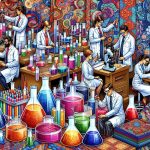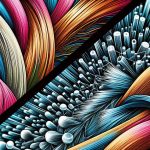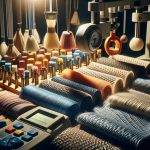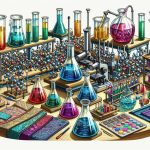You might not realize that the softness of your favorite T-shirt is meticulously engineered through chemical treatments. Chemistry influences every stage of textile production, from creating synthetic fibers with polymer science to achieving vibrant colors with precise dye formulations. Beyond aesthetics, chemical processes enhance the durability and comfort of fabrics while also incorporating innovative, eco-friendly methods. Ever wondered how textiles can be both soft and durable, or how they resist bacteria? The answers lie in the chemical principles that drive these advancements.
Table of Contents
Key Takeaways
- Chemistry enhances fiber properties like tensile strength and elasticity through polymer science.
- Dye chemistry provides vibrant colors and functional characteristics in textiles.
- Chemical treatments improve fabric durability, resistance to microbes, and comfort.
- Sustainable chemistry innovations reduce environmental impact with eco-friendly dyes and biodegradable materials.
- Coating technologies apply protective layers for water resistance and flame retardancy in textiles.
Fiber Creation
Fiber creation is where the magic of textile production begins, transforming raw materials into usable threads. Mastery over this process requires a deep understanding of spinning techniques and fiber properties. You'll need to explore various methods like ring spinning, rotor spinning, and air-jet spinning. Each technique offers distinct advantages, affecting the strength, elasticity, and texture of the final yarn.
When you're delving into fiber properties, consider elements like tensile strength, moisture-wicking ability, and thermal conductivity. These characteristics define how the fiber will perform in different applications, from high-performance sportswear to luxurious evening gowns. By comprehending these properties, you can tailor the fiber creation process to meet specific needs.
Nanotechnology applications are revolutionizing fiber creation, allowing for the manipulation of fibers at the molecular level. This can enhance properties like durability and stain resistance without compromising the fabric's comfort.
Moreover, sustainable practices are increasingly vital. Techniques such as using biodegradable materials or recycling waste fibers not only reduce environmental impact but also meet the growing consumer demand for eco-friendly products. By integrating these advanced methods and sustainable practices, you'll be at the forefront of textile innovation.
Polymer Science
Understanding polymer science is necessary for mastering the chemistry behind textile production. You need to comprehend the complexities of molecular structures and how they influence the formation of fibers. Polymers are long chains of repeating units, and their specific arrangements determine the material properties essential for textile applications.
When you explore chain reactions, you'll see how they're pivotal for polymerization processes. These reactions link monomers into polymers, creating the backbone of various fibers. By controlling these reactions, you can tailor the mechanical properties—such as strength, elasticity, and durability—of the resulting textiles to meet specific needs.
Investigating the molecular structures of polymers, you'll find that crystallinity and molecular weight play significant roles. Crystalline regions within a polymer enhance tensile strength and resistance, while amorphous regions contribute to flexibility. Balancing these aspects allows you to engineer materials with desired mechanical properties.
Polymer science also involves studying how additives and treatments affect a fiber's performance. For instance, adding plasticizers can improve flexibility, whereas stabilizers can enhance resistance to environmental degradation.
Mastering these concepts will enable you to innovate and optimize textile production, ensuring high-quality, functional fabrics.
Dye Chemistry
Building on your knowledge of polymer science, you'll find that dye chemistry plays a pivotal role in giving textiles their vibrant colors and functional characteristics. Understanding how dyes interact with textiles requires a thorough exploration into color theory and molecular structures. By mastering these concepts, you'll appreciate how specific dyes bind to fibers, resulting in long-lasting, vivid hues.
Dye chemistry isn't just about aesthetics. The environmental impact of dyeing processes has become a critical concern. Traditional methods often involve harmful chemicals and significant water usage, prompting the industry to explore sustainability efforts. Innovations in eco-friendly dyes and water-efficient techniques are transforming how we color textiles, aligning with greener practices.
Consider these fascinating aspects of dye chemistry:
- Molecular Structures: The arrangement of atoms in a dye molecule determines its color and bonding properties.
- Color Theory: Understanding how different dyes interact with light helps in achieving the desired shade and intensity.
- Sustainability Efforts: Advances in biodegradable dyes and closed-loop systems reduce pollution and conserve resources.
As you continue to explore dye chemistry, you'll uncover the intricate balance between achieving stunning visual effects and maintaining environmental responsibility. This knowledge will empower you to make informed decisions in textile production.
Textile Treatments
When you explore textile treatments, you'll find that dyeing and colorfastness are essential for vibrant, lasting colors.
Fabric softening agents improve the feel and flexibility of materials, making them more comfortable to wear.
Anti-microbial treatments guarantee that fabrics stay fresh and hygienic by preventing the growth of bacteria and fungi.
Dyeing and Colorfastness
Dyeing and colorfastness are important textile treatments that guarantee fabrics maintain their vibrant colors through wear and washing. Achieving exceptional color retention begins with effective dye penetration. You need to make sure that dyes thoroughly saturate fibers, embedding color deeply within the material. This technique is essential for fabrics to exhibit vivid hues that stand the test of time.
To prevent fading, consider the role of dye fixation. This process involves using chemical agents that bond dye molecules firmly to the fabric fibers. When dyes are well-fixed, they resist washing out and fading, even after repeated laundering. Proper dye fixation retains the fabric's brilliance, making your garments look new for longer.
Imagine textiles that:
- Retain their color after numerous washes
- Resist fading even under harsh sunlight
- Show consistent hues across different batches
Fabric Softening Agents
Fabric softening agents play an important role in enhancing the comfort and feel of textiles, making garments softer and more pleasant to wear. You'll find that these agents work through fabric conditioning, which involves modifying the fiber surfaces to reduce friction and improve pliability. This leads to performance enhancement, as the treated textiles not only feel softer but also drape better and are less prone to wrinkles.
Achieving this softness innovation often involves the use of cationic surfactants, which attach to the negatively charged fibers, smoothing them out. However, as you aim for mastery in textile chemistry, you should also consider sustainable solutions. Advances in green chemistry are enabling the development of eco-friendly softening agents derived from natural sources such as plant oils and biodegradable polymers.
When you opt for sustainable fabric softening agents, you're not just improving textile feel but also contributing to environmental preservation. These agents offer a balance between achieving superior softness and minimizing ecological impact.
Anti-Microbial Treatments
Anti-microbial treatments are vital for enhancing the hygiene and longevity of textiles by preventing the growth of harmful microorganisms. By integrating these treatments into your textile production process, you guarantee that your fabrics remain fresh and safe for extended periods. This not only improves fabric preservation but also aligns with sustainability goals by reducing the need for frequent replacements.
Imagine the benefits of textiles with strong antibacterial properties:
- Odorless athletic wear: No more lingering smells after intense workouts.
- Clean hospital linens: Enhanced safety for patients and staff.
- Durable outdoor gear: Gear that withstands damp conditions without developing mold or mildew.
These treatments imbue your textiles with enhanced functionality, making them more versatile and appealing to consumers who prioritize hygiene. They work by embedding antimicrobial agents into the fabric, which inhibit the growth of bacteria, fungi, and other microorganisms.
For those committed to mastering textile production, understanding the chemistry behind these treatments is essential. Selecting the right antimicrobial agents ensures peak performance and longevity, thereby contributing to both fabric preservation and sustainability. By focusing on these advanced treatments, you're not just improving the quality of your products; you're also making a positive impact on the environment and public health.
Enhancing Durability
To improve the durability of textiles, you can focus on strengthening fiber bonds and applying advanced coating techniques.
By incorporating chemical wear resistance, you'll guarantee fabrics withstand everyday use and harsh conditions.
These methods greatly extend the lifespan of textile products.
Strengthening Fiber Bonds
In textile production, enhancing fiber bonds is crucial for creating durable and long-lasting fabrics. By focusing on bond formation and chemical reactions, you can greatly improve fiber strength and the molecular structure of textiles. This ensures that your materials withstand wear and tear, maintaining their integrity over time.
To master the art of strengthening fiber bonds, consider these key techniques:
- Cross-linking agents: Introduce cross-linking agents to form additional bonds between polymer chains, enhancing the overall fiber strength and resilience of the fabric.
- Heat treatments: Applying controlled heat can induce chemical reactions that alter the molecular structure, making fibers more robust and less prone to breaking.
- Chemical finishes: Utilize specific chemical finishes that penetrate and fortify the fibers, providing added protection against environmental stressors like moisture and UV light.
Advanced Coating Techniques
When it comes to enhancing fabric durability, advanced coating techniques play a crucial role in providing additional layers of protection and functionality. You can achieve this by leveraging nanoparticle applications that improve the strength and resilience of the textile.
Nanoparticles, such as those made from silica or titanium dioxide, can be applied to fabrics to create a barrier against external elements like UV radiation and moisture. This not only extends the life of the material but also maintains its aesthetic appeal.
Surface modification techniques are equally essential for enhancing fabric durability. By altering the fiber surfaces at a microscopic level, you can embed functional properties directly into the textile. Techniques like plasma treatment or chemical vapor deposition allow for a more uniform and robust coating, greatly boosting the fabric's resistance to wear and tear.
These treatments can make fabrics hydrophobic, stain-resistant, and even antimicrobial. Mastering these advanced coating techniques requires a deep understanding of both the materials involved and the specific needs of the textile application. By integrating nanoparticle applications and surface modification techniques, you can push the boundaries of fabric performance, ensuring longevity and superior quality in your textile products.
Chemical Wear Resistance
Boosting fabric durability hinges on enhancing chemical wear resistance through innovative treatments and materials. You can notably extend the life of textiles by utilizing advances in polymer chemistry and friction resistance.
Imagine a world where your favorite fabrics not only last longer but also maintain their quality and appearance. This is achievable through precise chemical interventions.
Consider these cutting-edge approaches:
- Polymer Coatings: Applying advanced polymer coatings to fabrics enhances their structural integrity, making them more resistant to wear and tear.
- Nanotechnology: Incorporating nanoparticles into fibers boosts their strength and durability, providing a shield against chemical degradation and physical abrasion.
- Cross-linking Agents: Using cross-linking agents in fabric treatments creates stronger molecular bonds within the textile fibers, notably improving friction resistance.
Eco-Friendly Innovations
As the textile industry faces environmental challenges, innovative eco-friendly solutions are transforming how fabrics are produced. You can now leverage sustainable alternatives and biodegradable options, which minimize the ecological footprint of textile manufacturing. By integrating materials such as organic cotton, bamboo, and hemp, you're not only reducing harmful emissions but also ensuring the end products decompose naturally, contributing to a circular economy.
Harnessing renewable resources is another pivotal strategy. By utilizing solar and wind energy to power textile production, you're cutting down significantly on fossil fuel dependence. Green chemistry innovations further enhance this shift. For instance, waterless dyeing technologies and bio-based dyes eliminate the need for toxic chemicals, making the dyeing process safer for both the environment and workers.
Incorporating these eco-friendly strategies doesn't just fulfill regulatory requirements; it elevates your brand's reputation and appeal among eco-conscious consumers. When you adopt these practices, you're actively participating in the global movement towards sustainability, ensuring long-term benefits for both your business and the planet.
Coating Technologies
Coating technologies in textile production are revolutionizing fabric performance by adding functionalities like water resistance, flame retardancy, and antimicrobial properties. You can achieve these performance enhancements through innovative nanotechnology applications. By incorporating nanoparticles into coatings, you enhance fabric durability, offering superior protection without compromising comfort.
Imagine the benefits with these enhanced textiles:
- Water-repellent jackets: Stay dry even in the heaviest downpour.
- Fire-resistant uniforms: Safety and peace of mind for firefighters.
- Antibacterial hospital linens: Reduced infection rates and a safer environment.
Sustainable practices are vital in these advancements, minimizing environmental impact. Traditional coating methods often rely on harmful chemicals, but newer approaches use eco-friendly alternatives. For instance, you can adopt water-based coatings that reduce volatile organic compounds (VOCs), making the production process safer for both workers and the planet.
Nanotechnology applications also play a key role in sustainability. By using fewer materials, you can achieve the same, if not better, results, thereby conserving resources. It's a win-win: high-performance fabrics and a smaller environmental footprint.
Your mastery of these cutting-edge technologies won't only enhance textile performance but also contribute to a more sustainable future.
Future Trends
Building on the advancements in coating technologies, the future of textile production will focus on integrating smart materials and responsive fabrics that adapt to environmental changes. You'll see textiles embedded with sensors that monitor temperature, humidity, and even UV exposure. Such smart textiles will revolutionize not only fashion but also medical, sports, and military applications.
Sustainability initiatives will drive the adoption of eco-friendly chemicals and processes. You'll witness a shift towards bio-based dyes, waterless dyeing techniques, and the reduction of harmful effluents. These innovations will align with broader technological advancements in the industry, ensuring that production processes become more efficient and less polluting.
The circular economy will play an essential role in the future of textiles. You'll hear more about recycling and upcycling initiatives aimed at minimizing waste. Companies will increasingly adopt closed-loop systems where old garments are broken down and their components reused to create new products. This sustainable approach won't only conserve resources but also reduce the industry's environmental footprint.
Frequently Asked Questions
How Do Textiles Impact Skin Health and Allergies?
'An ounce of prevention is worth a pound of cure. Textiles directly impact skin sensitivity and allergy prevention. Choose hypoallergenic materials to minimize reactions and guarantee your skin stays healthy and irritation-free.'
What Are the Economic Implications of Advanced Textile Chemistry?
You'll find that advanced textile chemistry boosts cost efficiency and market growth. By driving innovation and sustainability, it enables companies to create high-quality products while reducing expenses and environmental impact, ultimately enhancing profitability and market competitiveness.
How Does Textile Chemistry Affect the Recycling Process?
Imagine a well-oiled machine: textile chemistry's precise control over chemical composition boosts recycling efficiency. By mastering these chemical processes, you can guarantee materials break down and reconstitute more effectively, reducing waste and conserving resources.
What Safety Measures Are Necessary When Handling Chemicals in Textile Production?
When handling chemicals, maintain proper ventilation to prevent inhalation of fumes. Always wear personal protective equipment like gloves and goggles to protect yourself. Adhering to these measures guarantees your safety and mastery of chemical handling.
How Has Textile Chemistry Evolved Over the Past Century?
Over the past century, you've seen remarkable chemical advancements in textiles. Innovations like synthetic fibers and eco-friendly dyes have revolutionized production while minimizing environmental impact, showcasing a blend of progress and sustainability in the industry.
- Aramid Nonwoven Fabric: An Engineer’s Guide - June 23, 2025
- Aramid Mylar Fabric: The Best of Both Worlds? - June 23, 2025
- Aramid Laminate Fabric Rolls: Benefits and Applications - June 23, 2025







